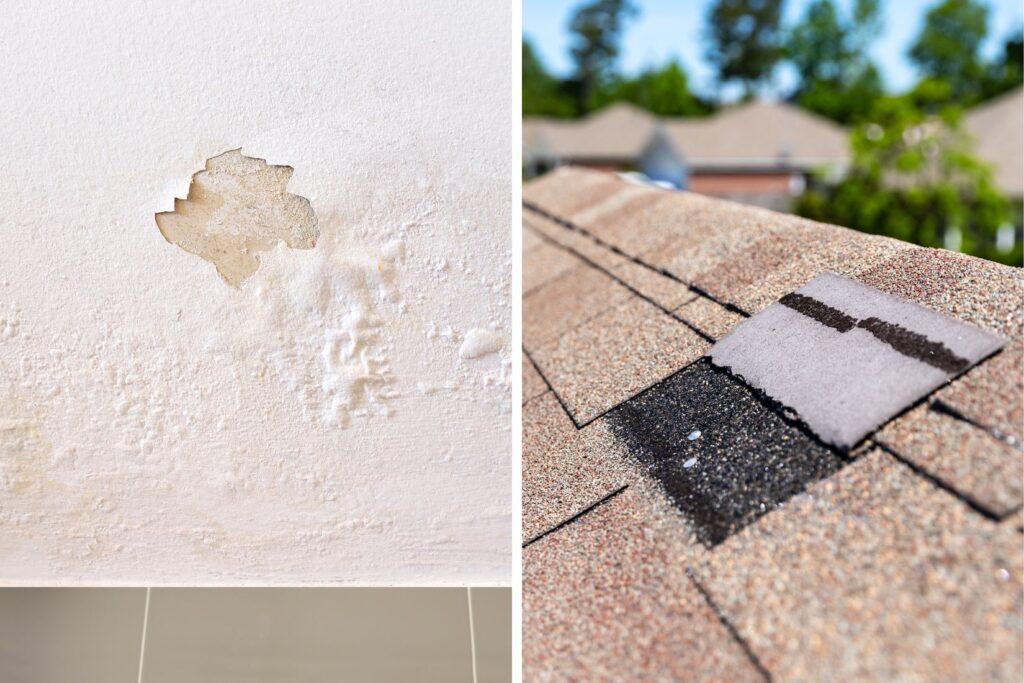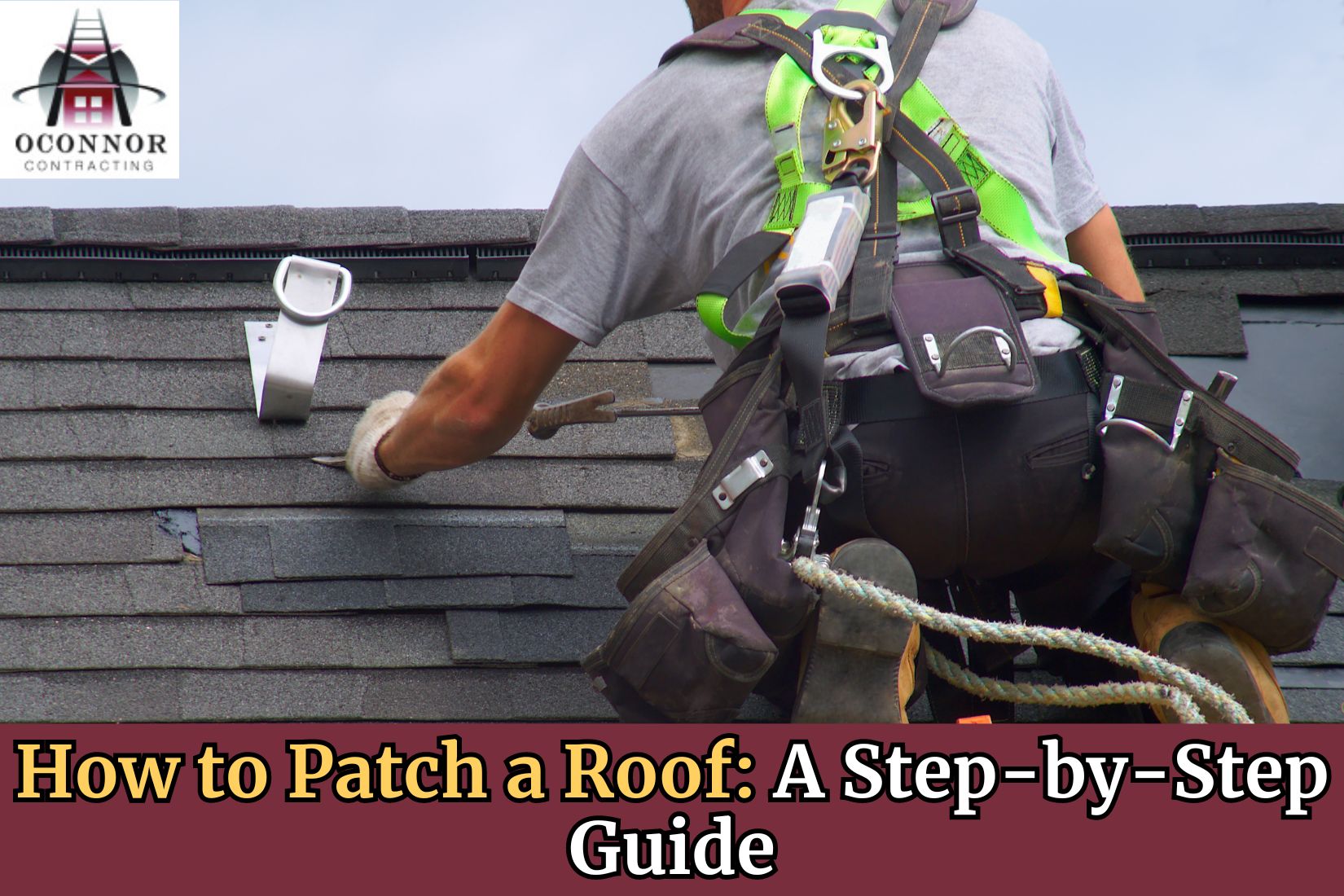Many homeowners underestimate the importance of regular roof upkeep, yet a well-maintained roof is vital for protecting your home from the elements. Surprisingly, the majority of roof leaks are due to poor installation or inadequate maintenance. By addressing roof issues promptly, you can avoid costly repairs in the future.
In this blog post, we will walk you through how to patch a roof, ensuring your home stays dry and safe.
When Is It Ideal To Patch A Roof?
Small issues such as tiny leaks, missing shingles, or light deterioration are best solved by patching. If the roof is in good condition and relatively new, it’s a quick and inexpensive fix.
When the damage is limited, patching can help you prevent more damage and save money by addressing the problem without having to replace the entire roof. However, replacing the roof is a better option if the damage is major or widespread over a large area.
Tools and Materials Needed
Before you start patching your roof, gather all the tools and materials you will need. This will make your work smoother and help avoid interruptions. Here’s a list of what you need:
Tools
| TOOLS | DESCRIPTION |
| Ladder | You need a strong ladder to safely reach your roof. Make sure it’s tall enough and on stable ground. |
| Utility Knife | Use this to cut roofing materials to the right size. A sharp blade works best. |
| Hammer | A hammer helps secure nails and patches. A roofing hammer with a flat head and claw is ideal. |
| Roofing Nails | These nails are made for roofing and are usually galvanized to resist rust. |
| Caulk Gun | This tool helps apply roofing cement or sealant smoothly and evenly. |
Materials
Choosing the right materials for roof patching is key for a strong and lasting repair. The materials you need will depend on your roof type.
A. Roofing Patching Material
Choose the right patching material based on your roofing material, such as new shingles for asphalt roofs, roofing cement for sealing, or a patching membrane for flat roofs.
B. Safety Gear
Prioritize safety by wearing gloves to protect your hands, goggles to shield your eyes from debris, and a hard hat to guard your head from falling objects.
Tip
You can find these tools and materials at your local hardware store. If you are unsure about what to buy, ask a roofing contractor for help. They can offer valuable advice based on your specific roofing needs.
Safety Precautions
Weather Considerations
Pick a clear, dry day for repairs. Avoid working in windy or rainy conditions as they can make the roof slippery. If rain is expected, wait until the weather is clear.
Personal Safety
Wear safety gear like well-fitting gloves, goggles, and consider using a safety harness to protect against sharp tools, debris, and accidents.
Identifying Roof Damage
Before fixing your roof, find the damage. Here’s what to look for:

A. Leaks
Look for water stains or peeling paint on ceilings or walls.
B. Missing Shingles
Check if any shingles are gone or broken.
C. Cracks or Holes
Spot any cracks or holes in the roofing material.
Preparing for the Patch
After finding the damage, the next step is to prepare the area for patching. Good preparation is key to making sure the repair lasts.
Clean Up the Area
Remove any old roofing material, loose shingles, and debris from the affected area. A spotless surface improves the patch’s adhesion. Make sure the surface is totally dry before continuing by using a leaf blower or broom to remove any remaining dirt.
Checking the Damage
To decide how to fix it, assess the damage. If it is major, you might have to replace larger portions of the roof. A basic fix can be sufficient for minor problems. Consulting with an experienced roofer is a smart idea if you’re unsure.
Step-by-Step Patching Process
Patching a roof requires careful attention to detail. Let’s delve in to help you through each step of the process.
Step 1: Gather Your Materials
Preparation is Key
Before starting, gather all the tools we have mentioned above. This makes the repair process smoother and faster.
- What to Gather: Get your ladder, utility knife, hammer, roofing nails, caulk gun, roofing cement, and patching material (such as new shingles or a patching membrane).
- Organize Your Workspace: Lay out your tools near the work area. Ensure your ladder is stable and on level ground. Keeping everything within reach saves time and effort.
- Double-Check: Before you begin, check to make sure you have everything you need. This helps avoid interruptions.
Step 2: Cut the Patch
Precision Matters
Cutting the patch material correctly is crucial for a good fit.
- Using the Utility Knife: Carefully cut the patch material to size. If using asphalt shingles, cut them to match the existing shingles around the damaged area.
- Size Consideration: Cut the patch slightly larger than the damaged area to ensure full coverage and a good seal against water.
- Matching Shingles: Try to match the color and style of the shingles to keep your roof looking good.
Step 3: Apply Roofing Cement
Create a Secure Base
Roofing cement helps the patch stick and prevents leaks.
- Using the Caulk Gun: Load the roofing cement into the caulk gun and apply a generous amount to the damaged area. Cover the entire area where the patch will go.
- Even Distribution: Spread the cement evenly for a solid base, avoiding gaps or thin spots that could lead to leaks.
- Thickness: Apply a layer thick enough to bond well, but not too thick to make it hard to place the patch.
Step 4: Place the Patch
Positioning for Success
Proper placement ensures a good seal and effective repair.
- Centering the Patch: Carefully position the patch over the damaged area, making sure it’s centered and covers all exposed sections.
- Pressing Down: Press the patch firmly onto the roofing cement to eliminate air pockets and ensure a solid bond.
- Check Alignment: Align the edges of the patch with the surrounding shingles for a uniform look.
Step 5: Secure the Patch
Fasten for Stability
Roofing nails keep the patch in place and secure.
- Using the Hammer: Use your hammer to nail the patch down, spacing the nails evenly around the edges, about 6 to 8 inches apart.
- Avoid Overdriving: Don’t drive the nails too deep, as this can weaken the patch. The nails should be flush with the patch surface.
- Additional Support: If the patch is large or in a windy area, add more nails for extra stability.
Step 6: Seal the Edges
Finalize the Repair
Sealing the edges of the patch prevents future leaks.
- Applying Roofing Cement: After securing the patch, apply roofing cement around its edges to keep water from seeping underneath.
- Creating a Watertight Seal: Cover the edges thoroughly to ensure a watertight seal.
- Smoothing the Cement: Use a putty knife to smooth the cement for a neat finish, helping it stick better and look clean.
Post-Patching Inspection
Once you’ve finished patching, it’s important to carefully inspect the repair to make sure it is secure.
A. Look for Gaps
Check the edges of the patch to ensure there are no gaps or exposed spots. If you find any, apply more roofing cement to seal them.
B. Check for Leaks
To test for leaks, use a hose to mimic rainfall. Spray water over the patched area and look for any signs of leaks inside your home. If you see any, fix them right away to prevent more damage.
Maintenance Tips Post-Repair
1. Inspect Regularly
Check the patched area often for cracks, peeling, or leaks. Catching issues early prevents bigger problems.
2. Keep the Roof Clean
Remove debris, leaves, and dirt from the roof. Clean surfaces last longer.
3. Trim Overhanging Branches
Cut back branches or shrubs that hang over the roof. This helps avoid scratches and damage.
4. Maintain Gutters
Keep gutters and downspouts clear of debris to prevent water from backing up and causing leaks.
5. Avoid Walking on the Roof
Limit foot traffic on the roof, especially where it is patched. Walking can damage the repair.
How Much Does It Cost To Patch A Roof?
For minor leaks, you can expect to pay between $200 and $1,000. Larger leaks might cost between $400 and $2,000. On average, homeowners spend about $1,200 on roof repairs. The final cost will depend on factors such as the type of roof, the size of the damaged area, and local labor rates if you choose to hire a professional.
Can You Patch A Roof Yourself or Should You Hire A Professional?
DIY roof repairs are cost-effective but are risky without proper experience. Roofing can be dangerous, and incorrect repairs can cause more damage. Professionals have the right tools, expertise, and insurance, and they offer warranties. Unless the repair is minor and you are confident in your skills, hiring a professional is safer and more cost-effective.
Patch Your Roof Like A Pro With OConnor Contracting’s Expert Services
Patching your roof is crucial to prevent further damage. With this guide, you can keep your roof in good condition. For expert roof repair services, consider OConnor Contracting. Our team provides professional and reliable roof repair services, ensuring your roof stays in the best shape. Give us a call at (716) 600-7663.


